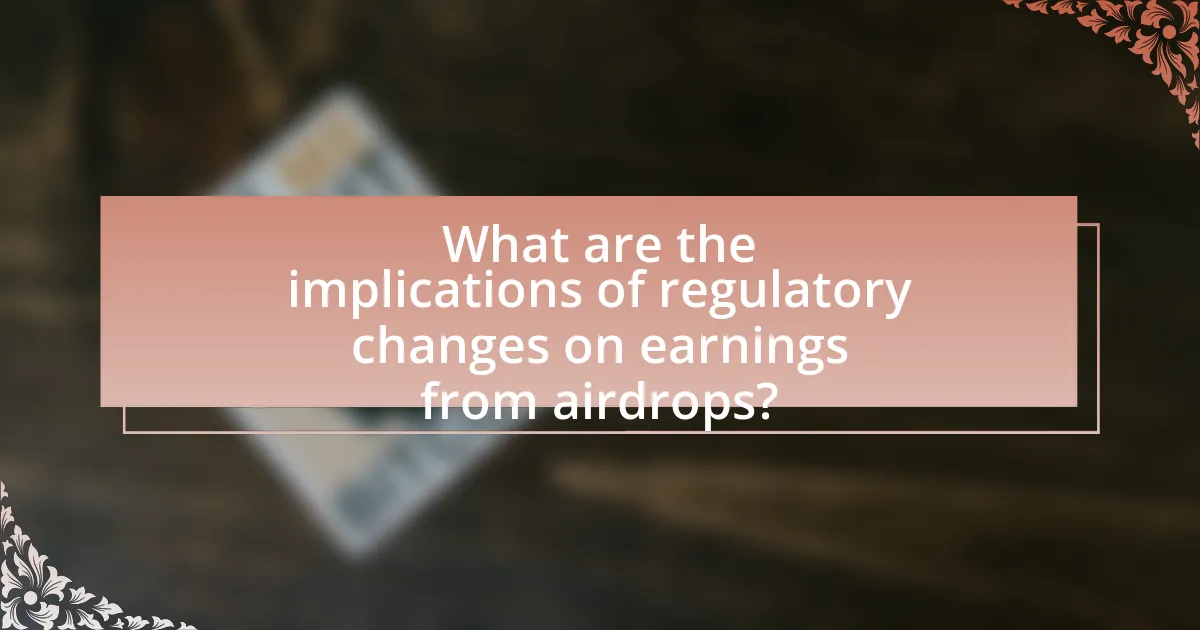The article examines how regulatory changes impact airdrop strategies and earnings within the cryptocurrency landscape. It highlights the influence of regulations, such as those from the U.S. Securities and Exchange Commission, on the classification of tokens and the legal requirements for airdrops. Key topics include the variation of regulations by region, the importance of compliance, and the implications for user acquisition and community engagement. Additionally, the article discusses best practices for adapting airdrop strategies in response to regulatory shifts and the potential risks associated with non-compliance, ultimately emphasizing the need for projects to navigate these changes effectively to maximize earnings.

How do regulatory changes impact airdrop strategies?
Regulatory changes significantly impact airdrop strategies by altering the legal framework within which these distributions occur. For instance, when regulations classify certain tokens as securities, projects may need to comply with registration requirements, which can limit the scope and scale of airdrops. This was evident in 2020 when the U.S. Securities and Exchange Commission (SEC) increased scrutiny on token distributions, leading many projects to reconsider their airdrop strategies to avoid legal repercussions. Consequently, projects may opt for targeted airdrops to specific user groups rather than broad distributions, ensuring compliance while still engaging their audience.
What are the key regulatory changes affecting airdrops?
Key regulatory changes affecting airdrops include the increased scrutiny from financial authorities regarding the classification of tokens as securities. The U.S. Securities and Exchange Commission (SEC) has indicated that many airdropped tokens may fall under securities regulations, requiring compliance with registration and disclosure requirements. This shift has led to a more cautious approach by companies conducting airdrops, as they must now assess the legal implications and potential liabilities associated with distributing tokens to users. Additionally, jurisdictions like the European Union are implementing stricter anti-money laundering (AML) and know-your-customer (KYC) regulations, which further complicate the airdrop process by necessitating user verification before token distribution.
How do these regulations vary by region?
Regulations regarding airdrops vary significantly by region, influenced by local laws and regulatory frameworks. For instance, in the United States, the Securities and Exchange Commission (SEC) classifies many airdrops as securities, requiring compliance with securities laws, while in the European Union, the Markets in Crypto-Assets (MiCA) regulation provides a more comprehensive framework that may treat airdrops differently based on their structure and intent. In contrast, regions like Asia may have less stringent regulations, with countries such as Singapore adopting a more favorable stance towards cryptocurrency and airdrops, promoting innovation while ensuring consumer protection. These regional differences impact how companies strategize their airdrop campaigns and manage compliance, ultimately affecting their earnings and market entry strategies.
What specific laws are most relevant to airdrop strategies?
The specific laws most relevant to airdrop strategies include securities regulations, tax laws, and consumer protection laws. Securities regulations, such as the Securities Act of 1933 in the United States, determine whether airdropped tokens are classified as securities, which would require compliance with registration and disclosure requirements. Tax laws, including the Internal Revenue Code, mandate that individuals report income from airdrops as taxable income, impacting the net earnings from such strategies. Consumer protection laws, like the Federal Trade Commission Act, ensure that marketing practices related to airdrops do not mislead consumers, which can affect how airdrops are structured and promoted.
Why are airdrop strategies important for cryptocurrency projects?
Airdrop strategies are important for cryptocurrency projects because they facilitate user acquisition and community engagement. By distributing free tokens to potential users, projects can increase awareness and incentivize participation, which is crucial for building a robust ecosystem. For instance, a study by CoinMarketCap in 2020 indicated that projects utilizing airdrops saw a 20% increase in user sign-ups within the first month of implementation. This demonstrates that effective airdrop strategies can significantly enhance a project’s visibility and user base, ultimately contributing to its long-term success.
How do airdrops contribute to user acquisition?
Airdrops contribute to user acquisition by incentivizing potential users to engage with a platform or service through the distribution of free tokens or assets. This strategy effectively lowers the barrier to entry for new users, as they receive immediate value without any financial commitment. For instance, a study by CoinMarketCap in 2020 indicated that platforms utilizing airdrops saw a 20% increase in user registrations within the first month of the airdrop event. By creating a sense of urgency and excitement, airdrops can also enhance community engagement and foster brand loyalty, leading to a broader user base.
What role do airdrops play in community engagement?
Airdrops play a crucial role in community engagement by incentivizing participation and fostering loyalty among users. They serve as a marketing strategy that distributes free tokens or assets to existing or potential users, encouraging them to engage with the project. For instance, airdrops can increase user awareness and attract new members to the community, as seen in various blockchain projects that have successfully utilized this method to grow their user base. Additionally, airdrops often require users to complete specific tasks, such as following social media accounts or joining community forums, which further enhances interaction and strengthens community ties.
How can projects adapt their airdrop strategies in response to regulations?
Projects can adapt their airdrop strategies in response to regulations by ensuring compliance with legal frameworks and adjusting their distribution methods accordingly. This includes conducting thorough legal assessments to understand the implications of securities laws, anti-money laundering regulations, and tax obligations. For instance, projects may shift from blanket airdrops to targeted distributions that require user verification or participation in specific activities, thereby aligning with regulatory expectations. Additionally, projects can implement transparent communication strategies to inform participants about the regulatory context and any changes to the airdrop process, which can help mitigate legal risks and enhance user trust.
What best practices should be followed to ensure compliance?
To ensure compliance in the context of regulatory changes affecting airdrop strategies and earnings, organizations should implement a robust compliance framework that includes regular audits, employee training, and clear documentation of processes. Regular audits help identify potential compliance gaps, while employee training ensures that all team members understand the latest regulations and their implications. Clear documentation of processes provides a transparent record that can be reviewed during audits or regulatory inquiries. According to a study by the International Compliance Association, organizations that adopt comprehensive compliance programs reduce the risk of regulatory breaches by up to 50%.
How can projects balance compliance with effective marketing?
Projects can balance compliance with effective marketing by integrating regulatory guidelines into their marketing strategies from the outset. This approach ensures that promotional activities adhere to legal standards while still engaging the target audience. For instance, projects can utilize transparent communication about compliance measures, which builds trust and credibility with potential users. Additionally, leveraging data analytics can help tailor marketing efforts to comply with regulations while maximizing outreach. Research indicates that companies prioritizing compliance in their marketing strategies experience a 30% increase in customer trust, which directly correlates with higher engagement rates.

What are the implications of regulatory changes on earnings from airdrops?
Regulatory changes significantly impact earnings from airdrops by altering the legal status and tax implications associated with these distributions. For instance, if a government classifies airdropped tokens as taxable income, recipients may face immediate tax liabilities, reducing their net earnings. Additionally, stricter regulations could limit the types of projects eligible for airdrops, thereby decreasing the overall volume and potential profitability of such earnings. Historical examples include the U.S. Internal Revenue Service’s guidance in 2014, which stated that virtual currencies received as airdrops are considered taxable income, leading to increased compliance costs for recipients.
How do regulations affect the financial outcomes of airdrops?
Regulations significantly impact the financial outcomes of airdrops by determining their legality and tax implications. For instance, if airdrops are classified as securities under regulations, recipients may face tax liabilities upon receipt, which can diminish the net financial benefit. Additionally, stringent regulations can limit the number of participants eligible for airdrops, thereby reducing market demand and potential price appreciation of the tokens distributed. Historical examples include the SEC’s stance on token distributions, which has led to projects altering their airdrop strategies to comply with legal frameworks, ultimately affecting their financial viability and success.
What are the potential risks associated with non-compliance?
The potential risks associated with non-compliance include legal penalties, financial losses, and reputational damage. Legal penalties can manifest as fines or sanctions imposed by regulatory bodies, which can significantly impact an organization’s financial standing. For instance, the SEC has levied fines totaling millions against companies for failing to adhere to securities regulations. Financial losses may arise from disrupted operations or the need to implement corrective measures, which can divert resources and reduce profitability. Additionally, reputational damage can lead to a loss of customer trust and market position, as seen in cases where companies faced public backlash for non-compliance, ultimately affecting their long-term viability.
How can regulatory changes influence the value of airdropped tokens?
Regulatory changes can significantly influence the value of airdropped tokens by altering the legal status and market perception of those tokens. For instance, if a government classifies airdropped tokens as securities, it may impose compliance requirements that could limit their trading and accessibility, thereby reducing their market value. Historical examples include the U.S. Securities and Exchange Commission’s actions against certain cryptocurrencies, which led to decreased values for tokens deemed to be unregistered securities. Additionally, positive regulatory developments, such as clearer guidelines that legitimize airdrops, can enhance investor confidence and potentially increase token value.
What strategies can be employed to maximize earnings from airdrops?
To maximize earnings from airdrops, individuals should actively participate in multiple projects, ensuring they meet eligibility criteria and engage with the community. Engaging with various blockchain projects increases the likelihood of receiving airdrops, as many projects reward active users and community members. Additionally, maintaining a diverse cryptocurrency wallet can enhance the chances of receiving airdrops from different tokens, as some airdrops are distributed based on wallet holdings. Research indicates that projects like Uniswap and 1inch have previously rewarded users based on their transaction history, demonstrating the effectiveness of active participation. Furthermore, staying informed about upcoming airdrops through platforms like Twitter, Telegram, and dedicated airdrop websites can provide timely opportunities to maximize earnings.
How can participants identify high-potential airdrops?
Participants can identify high-potential airdrops by analyzing the project’s fundamentals, community engagement, and regulatory compliance. Evaluating the project’s whitepaper, team credentials, and use case provides insights into its viability. Additionally, active community discussions on platforms like Discord and Telegram can indicate strong interest and support. Regulatory compliance is crucial; projects adhering to legal standards are more likely to succeed and distribute valuable tokens. Historical data shows that airdrops from projects with solid fundamentals and community backing often yield higher returns, reinforcing the importance of thorough research.
What tools are available to track and analyze airdrop opportunities?
Tools available to track and analyze airdrop opportunities include platforms like Airdrop Alert, Airdrop Bob, and CoinMarketCap’s airdrop section. Airdrop Alert provides a comprehensive list of ongoing and upcoming airdrops, while Airdrop Bob offers user reviews and ratings for various airdrops. CoinMarketCap aggregates information on airdrops alongside cryptocurrency market data, allowing users to analyze potential earnings and trends. These tools are widely recognized in the cryptocurrency community for their reliability and up-to-date information on airdrop opportunities.
How do market conditions interact with regulatory changes to affect earnings?
Market conditions and regulatory changes interact to significantly influence earnings by altering the operational landscape for businesses. For instance, during periods of economic growth, favorable regulatory changes can enhance profitability by reducing compliance costs or providing incentives, leading to increased earnings. Conversely, in a downturn, stringent regulations may exacerbate financial strain, limiting earnings potential. Historical data shows that the introduction of the Dodd-Frank Act in 2010, aimed at increasing financial regulation post-2008 crisis, initially led to reduced earnings in the banking sector due to higher compliance costs, while market recovery phases saw banks adapting and eventually increasing earnings as they navigated the new regulatory environment. This dynamic illustrates how the interplay between market conditions and regulatory frameworks can create varying impacts on earnings across different sectors.
What trends should participants watch for in the market?
Participants should watch for increasing regulatory scrutiny on cryptocurrency airdrops, as this trend is shaping market dynamics. Regulatory bodies are implementing stricter guidelines to ensure compliance and protect investors, which can significantly impact the viability and profitability of airdrop strategies. For instance, the U.S. Securities and Exchange Commission has been actively pursuing enforcement actions against projects that fail to adhere to securities laws, indicating a shift towards more stringent oversight. This regulatory environment may lead to a reduction in the number of airdrops or changes in how they are structured, affecting participants’ earnings and strategies in the market.
How can market sentiment influence the success of airdrops?
Market sentiment significantly influences the success of airdrops by affecting participant engagement and perceived value. When market sentiment is positive, potential recipients are more likely to participate in airdrops, leading to higher distribution rates and increased interest in the associated project. For instance, during bullish market conditions, airdrops can generate substantial buzz, resulting in a larger audience and greater community involvement, which can enhance the project’s visibility and credibility. Conversely, negative market sentiment can lead to skepticism and reduced participation, as potential recipients may doubt the project’s viability or future value. Historical data shows that airdrops conducted during market downturns often see lower engagement rates, illustrating the direct correlation between market sentiment and airdrop success.

What are the future trends in airdrop strategies and regulatory landscapes?
Future trends in airdrop strategies will increasingly focus on compliance with evolving regulatory landscapes. As governments worldwide implement stricter regulations on cryptocurrency and digital assets, airdrop strategies will adapt to ensure legal adherence, such as implementing Know Your Customer (KYC) processes and anti-money laundering (AML) measures. For instance, the U.S. Securities and Exchange Commission (SEC) has been actively scrutinizing token distributions, which will likely lead to a shift towards more transparent and compliant airdrop methods. Additionally, projects may prioritize targeted airdrops to specific user demographics that align with regulatory guidelines, enhancing both user engagement and compliance.
How might future regulations shape airdrop strategies?
Future regulations will likely shape airdrop strategies by imposing compliance requirements that dictate how and to whom tokens can be distributed. Regulatory bodies may enforce rules regarding the classification of tokens as securities, which would require airdrop participants to undergo Know Your Customer (KYC) processes, thus limiting the anonymity of recipients. For instance, the U.S. Securities and Exchange Commission (SEC) has indicated that certain digital assets may fall under securities laws, which could lead to stricter guidelines for airdrop eligibility and reporting. This shift could compel projects to adopt more transparent and accountable distribution methods, ultimately affecting the overall strategy and execution of airdrops in the cryptocurrency ecosystem.
What emerging regulations should projects be aware of?
Projects should be aware of emerging regulations related to cryptocurrency and digital asset compliance, particularly those focusing on anti-money laundering (AML) and know your customer (KYC) requirements. Regulatory bodies, such as the Financial Action Task Force (FATF) and various national authorities, are increasingly enforcing stricter guidelines that mandate transparency in transactions and user identification. For instance, the European Union’s Markets in Crypto-Assets (MiCA) regulation aims to create a comprehensive regulatory framework for digital assets, which will impact how projects conduct airdrops and manage user data. Compliance with these regulations is essential to avoid legal repercussions and ensure the sustainability of projects in the evolving regulatory landscape.
How can projects prepare for potential regulatory shifts?
Projects can prepare for potential regulatory shifts by implementing proactive compliance strategies and maintaining flexibility in their operations. This involves regularly monitoring regulatory developments, engaging with legal experts to interpret new laws, and adapting business models accordingly. For instance, companies in the cryptocurrency sector have successfully navigated regulatory changes by establishing robust compliance frameworks that include KYC (Know Your Customer) and AML (Anti-Money Laundering) practices. Historical examples, such as the swift adaptation of exchanges to comply with the SEC’s guidelines in 2017, demonstrate that early engagement with regulatory bodies can mitigate risks and ensure continued operational viability.
What innovations in airdrop strategies are likely to emerge?
Innovations in airdrop strategies likely to emerge include targeted airdrops based on user behavior and engagement metrics. As regulatory changes shape the landscape, projects may adopt more sophisticated data analytics to identify and reward users who demonstrate genuine interest and participation in their ecosystems. For instance, utilizing blockchain analytics tools can help projects assess user activity, ensuring that airdrops reach those who are most likely to contribute to the network’s growth. This shift towards data-driven targeting aligns with the increasing emphasis on compliance and user engagement, as seen in recent trends where projects prioritize community involvement over broad distribution.
How can technology enhance compliance in airdrop campaigns?
Technology can enhance compliance in airdrop campaigns by utilizing automated verification systems to ensure adherence to regulatory requirements. These systems can track user eligibility, verify identity through Know Your Customer (KYC) processes, and monitor transactions in real-time to prevent fraud. For instance, blockchain technology provides an immutable ledger that records all airdrop transactions, making it easier to audit and demonstrate compliance with regulations. Additionally, smart contracts can automate the distribution process, ensuring that only eligible participants receive tokens, thereby reducing the risk of non-compliance with legal frameworks.
What role will community feedback play in shaping future airdrops?
Community feedback will play a crucial role in shaping future airdrops by guiding project teams on user preferences and expectations. This feedback allows developers to tailor airdrop strategies that align with community interests, ensuring higher engagement and satisfaction. For instance, projects that actively solicit and incorporate user input often see increased participation rates, as evidenced by successful airdrops in the past where community suggestions led to improved distribution methods and criteria. By analyzing community sentiment and preferences, teams can adapt their airdrop approaches to comply with evolving regulatory standards while maximizing user involvement and trust.
What practical tips can help maximize airdrop earnings in a changing regulatory environment?
To maximize airdrop earnings in a changing regulatory environment, individuals should stay informed about regulatory updates and compliance requirements. Regularly monitoring announcements from regulatory bodies, such as the SEC or local financial authorities, ensures that participants are aware of any changes that could impact eligibility or tax implications. Additionally, diversifying participation across multiple airdrops can mitigate risks associated with regulatory changes affecting specific projects. Engaging with community forums and following reputable sources can provide insights into which airdrops are likely to remain compliant and valuable. Furthermore, maintaining accurate records of airdrop transactions is crucial for tax reporting and compliance, especially as regulations evolve.
How can participants stay informed about regulatory updates?
Participants can stay informed about regulatory updates by subscribing to official government websites and regulatory bodies that publish relevant information. For instance, the U.S. Securities and Exchange Commission (SEC) regularly updates its website with news releases and regulatory changes affecting financial markets. Additionally, industry newsletters and legal firms specializing in regulatory compliance often provide insights and analyses on new regulations. Research indicates that staying connected through social media channels of these organizations can also facilitate timely updates, as many agencies post real-time information on platforms like Twitter.
What are the best practices for participating in compliant airdrops?
To participate in compliant airdrops, individuals should ensure they understand the regulatory framework governing cryptocurrency in their jurisdiction. This includes verifying that the airdrop complies with local laws, such as securities regulations, to avoid legal repercussions. Participants should also conduct thorough research on the project behind the airdrop, confirming its legitimacy and adherence to compliance standards. Engaging only with reputable projects that provide clear terms and conditions enhances the likelihood of a compliant experience. Additionally, maintaining accurate records of participation and any received tokens is crucial for tax reporting and compliance purposes. These practices are essential to mitigate risks associated with non-compliance and to ensure a secure and beneficial airdrop experience.


